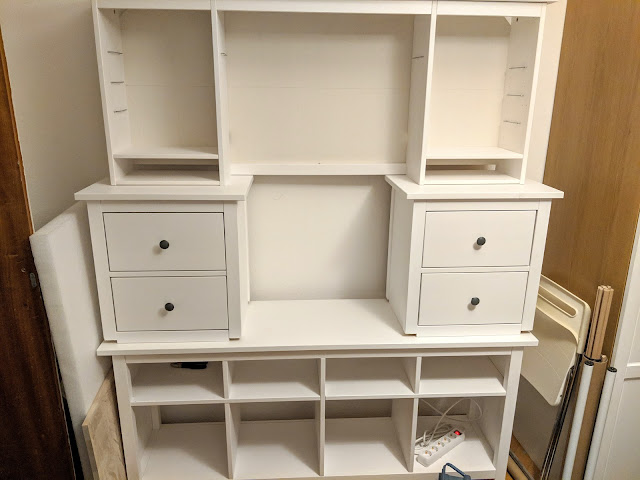Bullet Journals Without the Pastels
Late last year, +Riona MacNamara introduced me to the idea of bullet journals, and I decided to give it a try over Christmas. It worked out for me and has seriously helped me getting shit done, without a snowfall of post-it notes to keep track of things (I have graphs and data to back this claim up, see the Statistics section). There are many pages describing bullet journals, most of them showing intricately decorated journals done in pastels. If you're allergic to pastels, or don't have time to decorate your planner, here's my explanation. Guaranteed no florals - hell, I can't even do a straight line.
The future tracker is where you keep tasks that you want to get around to eventually, but either don't have time for just yet, or they need to happen at a certain time, like doing taxes or shipping Christmas presents.
The monthly tasks tracker is for tracking tasks you should get done soon - this acts as a pool for tasks to pull up and do on an appropriate day (this month got split over two folds, not a good idea).
The daily tasks tracker is where you put things you want/need to get done today. Tasks here should (like in Getting Things Done) be concrete and actionable, and you shouldn't have too many - except for truly time-critical things, I try to keep this down to 5 tasks.
While the journal can also be used for random notes (indicated with a dash) and events (indicated with a ring), the task tracking is the important part. In my view, the bullet journal's main strength is that is allows for the facts of real life: you don't always get everything done nicely and tidily. Sometimes you get distracted, some things are harder than you thought, sometimes you just don't have the energy. So it has a simple system for updating your tasks:
A task that has been done is marked with a cross (or, as I prefer, a checkmark).
A task that has been scheduled (i.e. given a more specific time) is marked with a greater-than.
A task that has been put off (i.e. moved to a later time of the same granularity) is marked with an arrow.
A task that has been migrated (i.e. moved to a more general time) is marked with a less-than.
These markings and other notation are summarized in a legend at the inside cover.
I do an update first thing in the morning when I add the new day's entry. Tasks I didn't get around to the day before will be migrated either to the new day if I still think I can get around to it, or up to the monthly tracker if other things have gotten in the way. Having to migrate the previous day's tasks encourages me to de-schedule things I'm unlikely to get around to as well as getting the things done.
Task Tracking
Here are the three parts of my bullet journal I use the most, the task tracking parts. It has three levels: generic future tasks roughly by month, tasks for the current month, and tasks for today.The future tracker is where you keep tasks that you want to get around to eventually, but either don't have time for just yet, or they need to happen at a certain time, like doing taxes or shipping Christmas presents.
 |
| Long-term task tracker (left side) |
 |
| Monthly planner. Not used that much. Daily task tracking columns added just the day before |
 |
| Monthly task tracking. Used a lot. |
 |
| Two days of daily task tracking, with tasks not done migrated to later days |
While the journal can also be used for random notes (indicated with a dash) and events (indicated with a ring), the task tracking is the important part. In my view, the bullet journal's main strength is that is allows for the facts of real life: you don't always get everything done nicely and tidily. Sometimes you get distracted, some things are harder than you thought, sometimes you just don't have the energy. So it has a simple system for updating your tasks:
A task that has been done is marked with a cross (or, as I prefer, a checkmark).
A task that has been scheduled (i.e. given a more specific time) is marked with a greater-than.
A task that has been put off (i.e. moved to a later time of the same granularity) is marked with an arrow.
A task that has been migrated (i.e. moved to a more general time) is marked with a less-than.
These markings and other notation are summarized in a legend at the inside cover.
 |
| Legend (slightly outdated) |
I do an update first thing in the morning when I add the new day's entry. Tasks I didn't get around to the day before will be migrated either to the new day if I still think I can get around to it, or up to the monthly tracker if other things have gotten in the way. Having to migrate the previous day's tasks encourages me to de-schedule things I'm unlikely to get around to as well as getting the things done.
Index & collections
The task tracking is the most important part for me, as it's what helps me get shit done. But there are other cool ideas in this system.
The first few pages are dedicated to an index. If your book doesn't have page numbers, just add them, and then add the page numbers in the index if a page has something relevant to a particular subject:
By having the page numbers on the right, it's pretty easy to add more pages, so the subject can be tracked across many instances. As you can see, I'm not using this all that much yet.
Notes and events should be kept short - the day planner should not drown in them - so if you want to write more on a subject, dedicate a page (or more) to it, referring to it in the index. I have only done that a little bit, but will probably do it more in my work journal.
The first few pages are dedicated to an index. If your book doesn't have page numbers, just add them, and then add the page numbers in the index if a page has something relevant to a particular subject:
 |
| Index |
Notes and events should be kept short - the day planner should not drown in them - so if you want to write more on a subject, dedicate a page (or more) to it, referring to it in the index. I have only done that a little bit, but will probably do it more in my work journal.
Modifications
Bullet journaling is explicitly modifiable, and I've changed a few things and am looking at a few other.
Instead of an X for tasks done, I use a checkmark - just feels better. I might use X then for cancelled jobs, and use strike-through for anything that's either done, moved, or cancelled. It's not a big deal in the daily section, but in the monthly section using strike-through would help scanning for pending tasks.
I use < for things migrated to longer-term (day to month or month to longer-term) and > for things scheduled (long-term to month, month to daily), but for things that move at the same level (monthly to monthly or most commonly daily to daily), I changed to using ->, and at the suggestion of my wife (who has also taken up this system, with some variations of her own), adding one more dash per day it gets moved, so I can see how many times a task has been moved. The triple-arrow you can see in the picture of the 14th's page had my first triple-moved tasks, which got to quintuple before I finally got it done. The embarrassment!
I add a little extra data on the header of the daily entries: Where I am, what the weather is like, and how I slept.
I haven't been using my monthly day overview much, but I recently added tracking for a couple of things I want to get done regularly. As you can see, I need to work on that bit. Having the month overview and tasks on the same fold would probably work better, as I would get reminded more.
One problem I'm still considering what to do about is that when getting close to the end of a day, month, or long-term period, you get things you really want to put on the page-to-be, because you know you can't do them in the current period. I'm considering changing the long-term plan to cover 5 months and a "future" section, and then making a new one after 4 months, so there's never a time without at least one full month and future section available.
I use a paper journal partly because I don't trust my phone to not run out of battery at an inconvenient time, but mainly because if I used my phone, I would immediately get distracted and forgot what I was about to put in the journal. And it works really well, especially with having a little pen strap at the back of the book and a elastic band over all the unused pages. That way I can open to the daily page with my left hand and get my pen ready with my right hand very quickly. The two bookmark strips are handy for marking the monthly and long-term pages.
Statistics
After my first three weeks of journalling, I did some statistics on my tasks. This was a couple of days before the pictures above were taken.
I entered a total of 74 tasks in the daily sections in the first 21 days. Of these, 49 got done the same day, 12 got done the next day, 3 the day after, 4 got migrated to monthly or long-term, and 6 got cancelled. Four days had no tasks done, two of which I was travelling, and two were work-days (I'm excluding the few work-related items I entered because they eventually got moved to a separate journal).
Of the 33 tasks entered in my January section, 14 have gotten done by the 15th, and two got cancelled because I didn't get them done before I left the relevant country.
Since I did these statistics, I managed to get a task up to five bars on the forward arrow, but I did get it done. That's the kind of task that would otherwise have laid forgotten in a corner until I saw it several months later and thought, "oh, yeah, I ought to have done that, but I keep forgetting". Amazingly, this journal system helps me avoid that sad fate, and Gets Shit Done.
Further good reading:
lifehacker.com: The Bullet Journal, Minus the Hype, Is Actually a Really Good Planner
The original Ryder Carroll video that introduced the concept.
Since I did these statistics, I managed to get a task up to five bars on the forward arrow, but I did get it done. That's the kind of task that would otherwise have laid forgotten in a corner until I saw it several months later and thought, "oh, yeah, I ought to have done that, but I keep forgetting". Amazingly, this journal system helps me avoid that sad fate, and Gets Shit Done.
Further good reading:
lifehacker.com: The Bullet Journal, Minus the Hype, Is Actually a Really Good Planner
The original Ryder Carroll video that introduced the concept.



Comments
Post a Comment